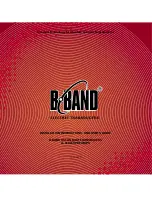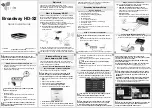
MDS 05-3316A01, Rev. E
MDS 4710B/9710B I/O Guide
11
Do not use a 25 wire (fully pinned) interface cable for connection to the
DATA INTERFACE
connector. Use only the required pins for the applica-
tion. Damage will result if improper connections are made. Typical
applications require the use of only Pins 1 through 8 for RS-232-type
signaling. When using an external modem (4-wire audio arrangement),
only Pins 7, 9, 11 and 16 are typically required.
CAUTION
USE ONLY THE
REQUIRED PINS!
Table 5. Data interface connector pinouts
Pin
Number
Input/
Output
Pin Description
1
--
Protective Ground. Connects to ground (negative supply
potential) on the radio’s PC board and chassis.
2
IN
TXD—Transmitted Data. Accepts TX data from the connected
device.
3
OUT
RXD—Received Data. Outputs received data to the connected
device.
4
IN
RTS—Request-to-Send Input. Keys the transmitter when RTS
asserted.
5
OUT
CTS—Clear-to-Send Output. Is active after the programmed
CTS delay time has elapsed.
6
OUT
DSR—Data Set Ready. Provides a +6 Vdc DSR signal through
a 2.5 k
Ω
resistor.
7
--
Signal Ground. Connects to ground (negative supply potential)
at radio’s PC board.
8
OUT
DCD—Data Carrier Detect. Goes active when the radio
detects an on-frequency signal.
9
IN
Transmit Audio Input. Connects to the audio output of an
external (AFSK) modem. The input impedance is 600
Ω
. Use
Pin 7 for the modem’s return lead. The audio level can be
adjusted using the TXLEVEL [–20...+3, AUTO] command.
10
OUT
RUS—Receiver Unsquelched Sensor. Not used in most
installations, but is available as a convenience. Pr8 Vdc
through a 1 k
Ω
resistor whenever the receiver squelch is open,
and drops to less than 1 Vdc when the squelch is closed.
11
OUT
Receive Audio Output. Connects to the audio input of an
external (AFSK) modem. The output impedance is 600
Ω
, and
the level is factory set to suit most installations. Use Pin 7 for the
modem’s return lead. The audio level can be adjusted using the
RXLEVEL [–20...+3] command.
12
IN
Radio Inhibit. A ground on this pin places the radio into the
“sleep” mode. It turns off most circuits in the radio, including
transmit, receive, modem and diagnostic functions. This allows
for greatly reduced power consumption, yet preserves the
radio’s ability to be quickly brought on-line.
13
--
Do not connect—Reserved for future use.
14
--
PTT—Push to Talk. This line is used to key the radio with an
active-high signal of +5 Vdc.
















































